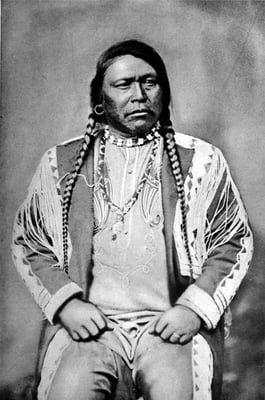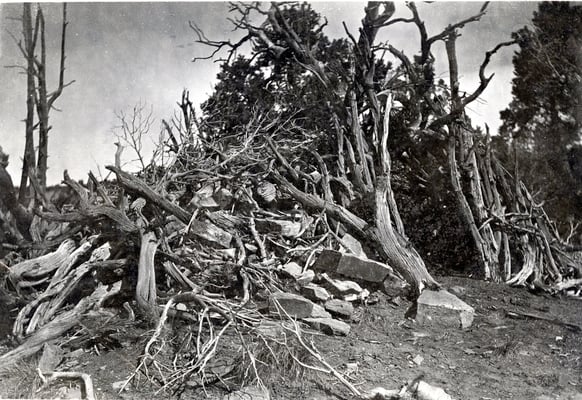On a sage-covered mesa overlooking the Eagle River, two boys hunch over a giant anthill. With intense focus, they flick agile fingers through tiny pebbles the hard-working ants bring up from below.
“There’s another one!” the elder boy shouts, pinching a tiny turquoise bead between finger and thumb. He carefully drops it into a jar and high-fives his brother. They’ve found another treasure left by Ute natives who lived in the Rocky Mountains in pre-European times. The beads, possibly as old as 500 years, were likely trade beads left behind by Northern Utes, one of three Ute tribes whose vast Territory once included most of Utah and Colorado, and whose hunting and trading forays extended into Kansas, Oklahoma, New Mexico, and Texas.
 The Nuchu created a vast network of trails throughout Colorado. Many were used by the mountain men, and later by European settlers. Some, like this one over Ute Pass in Teller County, is used today as a two-lane paved road. (Image courtesy of the Eagle County Historical Society, Eagle Valley Library District.)
The Nuchu created a vast network of trails throughout Colorado. Many were used by the mountain men, and later by European settlers. Some, like this one over Ute Pass in Teller County, is used today as a two-lane paved road. (Image courtesy of the Eagle County Historical Society, Eagle Valley Library District.)
According to archeologists, humans have occupied this area for 10,000 years. Utes – or Nuchu, meaning The People – were likely here for 1,000 years. The Spanish Escalante expedition documented Utes in the Eagle Valley when it passed through in 1776.
Nuchu led nomadic lives, meandering along their vast trail network with the seasons, from winters in Utah, to our high Rocky Mountain valleys in summer, where they fattened their prized horses on rich grasses, hunted big game, and harvested abundant plants.
Women and children fished and tanned hides, and gathered roots, berries, and seeds. Men hunted game and traded horses. Nuchu were known for excellent horsemanship, fine buckskins, and beadwork. Their mastery of horses gave them the advantage of speed, mobility, and portability, making traveling to and from the mountains a sustainable way of life.
 Chief Ouray was a powerful Nuchu leader. With the support of his sub-chiefs and his wife Chipeta, Chief Ouray led his proud people through difficult transitions with white settlers, including plagues, land forfeitures, and relocation to reservations. (1874 photo)
Chief Ouray was a powerful Nuchu leader. With the support of his sub-chiefs and his wife Chipeta, Chief Ouray led his proud people through difficult transitions with white settlers, including plagues, land forfeitures, and relocation to reservations. (1874 photo)

The Nuchu’s extensive trail network was used by early mountain men, and later as roads for white settlers. Some are popular hiking trails today in Rocky Mountain National Park, Ute Pass, and the historic Ute Trail in Dotsero.
Mount Evans, named for the disgraced Governor who oversaw the Sand Creek Massacre, is slated for a new moniker, Mount Blue Sky.
Susie Kincade is a Nature-based Coach, Earth Activist, and Founder of the Women’s Empowerment Workshop. She lives in Eagle, CO.









